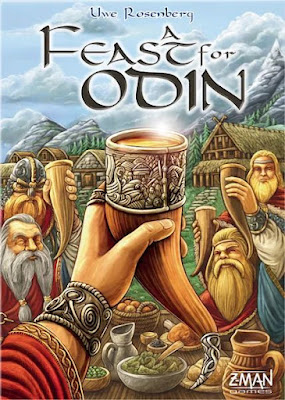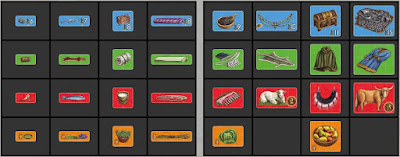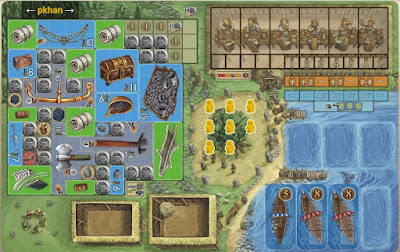The Game
A Feast for Odin is one of Uwe Rosenberg's most popular titles. This is a heavy Eurogame about the history of the Vikings. You manage a Viking tribe. You will get to farm, fish, hunt, mine, raid, discover new lands and also settle new lands. This is a worker placement game. This is also a game of polyominoes - you use them to fill up your player boards. Uwe Rosenberg has many games which use polyominoes.
The board on the left is the main board. This is where you place workers to claim spots in order to perform actions. There are close to 70 different spots. When I first saw this it drove me nuts. This is analysis paralysis hell, or listening-to-long-rules-explanation hell. When you place your workers, you get to do things like collecting resources, upgrading them, converted them to other resources, and claiming new player boards. The main board is divided into four columns. To claim a spot in the first column you only need one worker. The spots in the second column require 2 workers. The third column 3 workers, and so on. The more workers an action requires, the more powerful it is.
The board on the right is your player board. You can place your green and blue resources (the polyominoes) here. You can use coins to cover spots here too. There are three main elements to highlight. First, the diagonal line of coin icons. This is your income track. Along this line, the lowest number still visible is your income at the start of every round. So you want to cover as many of the smaller numbers as possible. You can't just cover the coin spots. For each coin spot you want to cover, you must first cover all other spots to its left, below it, and to its lower left. This means you will be filling your board from the lower left corner, and you have to fill a complete square growing towards the top right. This is how you gradually increase your income.
The second thing to highlight is those spots which show a resource. You need to surround these spots to be able to produce these resources every round. The third thing is that swath of negative point spots. Before the game ends you must try to cover most if not all of them. Otherwise, you will lose points.
Throughout the game you have opportunities to claim additional player boards. They are farmhouses you can build and islands you can discover. They help you score points, generate income and produce resources. However there are risks when claiming them, because if you fail to fill them up sufficiently, you will be losing points.
This part of the player board is the banquet table. At the end of every round you must hold a feast for your tribesmen. Your tribe keeps growing every round, which means you need to prepare more and more food. Red and orange resources are food. After a red resource is upgraded to green, it becomes merchandise and you can't eat that anymore. In case you don't have enough food, you can give your people pocket money (see the coins in the screenshot above). They are okay with that. When preparing the feast, resources of the same colour must not be adjacent. That is why my food platters alternate between red and orange. To reduce this food demand, you can place ships here. What this means is you are sending some of your people off to live in colonies. They'll take care of themselves and you don't need to feed them at HQ anymore. Sacrificing your ships this way means you will have fewer ships for activities like whaling and raiding, but in addition to reducing the food requirement, this also gives you points.
There are many resource types in the game. These are just those in tile form. There are also resources in the form of wooden pieces, like wood, stone and iron. Resources in tile form have four grades, the lowest being orange and the highest blue. You can upgrade them through the levels. Red and orange are food you can feed your people with. Green and blue are merchandise used for filling your player board.
Bear Island is an additional player board you can claim. The 12 at the top right means victory points. The 22 at the top left tells you this board starts with a penalty of 22 points. You need to fill the board up to avoid or reduce this penalty. At this point I still had four spots to go, but eventually I managed to fill up the whole thing. Notice that green tiles must not touch one another. Blue is fine. This is another thing you have to manage and plan for.
The game is played over a fixed number of rounds, after which the highest scorer wins.
The Play
The first time playing the game, I spent a lot of time studying the main board. There are so many different things you can do it is daunting. Ultimately it is about collecting resources and tools, or resources for making tools. Some actions come with some risk. You need to roll a die to see if you succeed. Having tools for these is necessary, and the more tools you have, the higher the chances of success. Thematically, placing workers on the spots means activities like hunting, fishing, mining, raiding and so on. The game presents these as having assigned workers to obtain resources of different types. Actions can be categorised into general groups, like animal husbandry, exploration, construction, and whaling, so there are specific industries you can decide to focus on. When you specialise, you will be more efficient and productive.
I did a 2-player game with Han, and the main board felt pretty spacious. We didn't compete hard. With more players the game will be more challenging. There were still some things I wanted to do which Han did before I could, but these were not life-and-death like baking bread to feed your family in Agricola. You should still watch what your opponents might be planning to do, and prioritise your actions accordingly.
The game is about efficiently collecting and converting resources. The more resources you have, the more points you can score. Polyominoes are heavily used, so this is a game with a strong spatial element. You will be fiddling with tiles on your boards throughout the game. This is a fun thing to puzzle out.
This was the final round, and I still had so many negative point spaces I hadn't filled. I was a little worried whether I had played a horrible game (as in my gameplay, not the game itself). I was rather clueless in the early game, unsure what was a good move and what wasn't. I felt I wasn't very efficient. Thankfully by the end of the round I did manage to fill up my board. I wasn't as bad as I thought.
Han utilised the grey tiles much better than I did. There is an action which lets you buy these grey, oddly shaped tiles. They can be very helpful in filling your board, especially when you need to do weird stuff like surrounding certain spaces without covering them.
The Thoughts
This game has a very strong Uwe Rosenberg signature. If you like his games, you'll likely enjoy this too. The game world is big. You have many options to gather and upgrade resources in order to fill your boards. This being a worker placement game means naturally there is some competition and blocking of worker placement spots. Mine being a 2-player game, the competition wasn't too intense. If there were things I wanted to do but I couldn't, there were still many other options. With three or four players this would be different. BGG says three is the ideal player count. I wonder whether this is preferred over four players because otherwise competition would be too brutal, or game time would be too long. For me, A Feast for Odin does not present anything particularly new. If I were to summarise it in one sentence, it is a game about collecting pieces to fill your board. Put that way, it sounds a little lame. It is a solid game. There are several tactical considerations which give you much to think about. If you like heavy Eurogames this is right up your alley.







2 comments:
I've played all of 2 whole times, so as an expert, i would agree with your assessment - i had fun, it was a 'good game', but wasn't anything to write home about. it was fine for me. i'd play again but never did buy it. a VERY complex tetris. dw
haha I try to make myself sound like an expert after playing many games once
Post a Comment